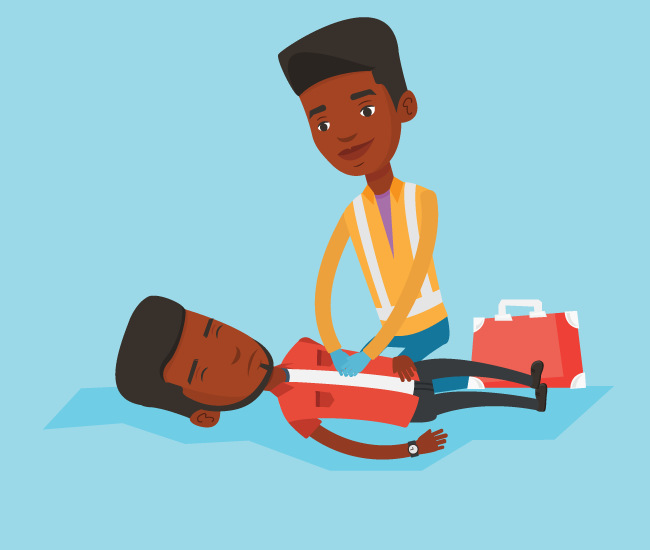When you hear about CPR on television, the news, or anywhere else, most people do not take the time to get into the different types that can be performed. Maybe you thought there was only one type of CPR, but this is absolutely not the case!
There are two types of CPR that you can perform, standard and hands only. We’re going to get into hands-only CPR specifically, including what it is and how to perform it properly. Read on to learn how you can make a difference in an emergency.
What is hands-only CPR?
This answer is pretty straightforward. As you might have guessed, in this method, you only use your hands to perform chest compressions to keep blood flowing. In a standard CPR procedure, you would do 30 chest compressions followed by two rescue breaths and then repeat the cycle. With hands-only CPR, you don’t have to worry about rescue breaths, just compressions.
Why would you use hands-only CPR?
You may be wondering why you would use hands-only CPR instead of the more common method with compressions and rescue breaths. While there are situations where rescue breaths are appropriate, there are reasons to use hands-only CPR.
First thing’s first– when would you use hands-only CPR?
- When a person suffers from cardiac arrest outside of the hospital. Within the first few minutes of a cardiac arrest, hands-only CPR is an appropriate intervention until emergency services arrive. If the person stops breathing, rescue breaths can be initiated because oxygen is necessary for brain function.
- If you are a bystander of an accident and the victim is someone that you do not know. Many people feel uncomfortable putting their mouth to a stranger’s lips, even when it could save a life. Some people also might not feel confident that they know how to do rescue breaths correctly. These concerns are valid and part of the reason that hands-only CPR was developed. It has been just as effective as traditional CPR in some cases. Please use your best discretion.
Why might someone choose to do hands-only CPR over CPR with rescue breaths?
We touched on the fact that bystanders may be uncomfortable giving rescue breaths to strangers unless it is absolutely necessary – and sometimes not even then. While you should do whatever you can to save someone’s life, there is always the concern that a person may be infected with a communicable disease. If you are particularly vulnerable to those things, you may choose to do hands-only CPR instead. Only do it if the situation calls for it, though.
How do you perform hands-only CPR on an adult?
Now that you understand when and why to perform hands-only CPR, let’s get into how to go about it. Follow instructions as closely as possible for the best results. Paying attention to the details increases the chances that the person you are rescuing survives.
- If you see someone suddenly collapse, try to get their attention. Tap them on the shoulder and loudly ask if they are okay. If they do not respond and don’t appear to be moving or breathing, prepare to perform CPR.
- First, call 911. You need both hands and all of your focus for CPR and once you start, you really shouldn’t stop so call emergency services beforehand. They will get to you quickly as long as you call for help right away.
- Make sure the person is lying face up on a flat surface. Keep the airway open, making sure that there are no obstructions and that the head is tilted slightly upward.
- Begin chest compressions by placing the heel of one hand on the center of the person’s chest and the other hand on top. Interlock your fingers and press down with the heel of your hand, keeping the elbows straight.
- Do at least 100 compressions per minute and press down at least two inches into the chest. An easy way to make sure you’re using the proper speed is to use the beat of “Stayin’ Alive” by the Bee Gees as it matches the tempo of compressions.
- Keep doing this until someone else can take over or until medical personnel arrives.
Which is more effective: hands-only or traditional CPR?
The efficacy of hands-only CPR has been questioned because CPR with rescue breaths has been proven effective time and time again. The truth is that traditional CPR is almost always preferable to the hands-only method. If you can give rescue breaths, you should, especially in cases where children or infants are involved.
If you can’t give rescue breaths, hands-only CPR is still far better than standing by and doing nothing. Most cases of cardiac arrest out of the hospital result in people dying, especially if no one jumps in to help. Be the hero that someone needs; perform the CPR technique that is best for the situation and your comfort level.
Where can you get CPR certified?
Though you do not have to be CPR certified to try to use it in the event of an emergency, it is always better to be as prepared as possible. The more you learn, the more prepared you are to help someone survive. In the past, CPR certification required finding a class in your area and trying to find the time to take one. That is no longer the case! ProCPR offers CPR training online for a low cost and you only need to pay if you pass the course and need your certificate. It takes very little time out of your day to learn these essential skills. You have nothing to lose by getting educated on proper ways to perform CPR, but someone may have everything to lose if you don’t.
